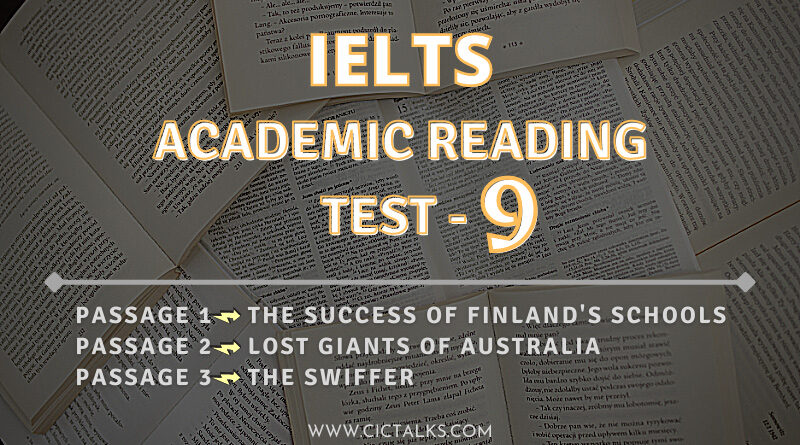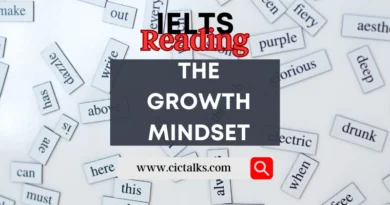IELTS Academic Reading Free Practice Test
The Swiffer – IELTS Reading Passage With Answers
You should spend about 20 minutes on Questions 27-40, corresponding to Reading Passage 3 given below.
| For a fascinating tale about creativity, look at a cleaning product called the Swiffer and how it came about, urges writer Jonah Lehrer. In the story of the Swiffer, he argues, we have the key elements in producing breakthrough ideas: frustration, moments of insight and sheer hard work. The story starts with a multinational company which had invented products for keeping homes spotless, and couldn’t come up with better ways to clean floors, so it hired designers to watch how people cleaned. Frustrated after hundreds of hours of observation, they one day noticed a woman do with a paper towel what people do all the time: wipe something up and throw it away. An idea popped into lead designer Harry West’s head the solution to their problem was a floor mop with a disposable cleaning surface. Mountains of prototypes and years of teamwork later, they unveiled the Swiffer, which quickly became a commercial success. Lehrer, the author of Imagine, a new book that seeks to explain how creativity works, says this study of the imagination started from a desire to understand what happens in the brain at the moment of sudden insight. ‘But the book definitely spiraled out of control,’ Lehrer says. ‘When you talk to creative people, they’ll tell you about the ‘eureka’ moment, but when you press them they also talk about the hard work that comes afterwards, so I realised I needed to write about that, too. And then I realised I couldn’t just look at creativity from the perspective of the brain, because it’s also about the culture and context, about the group and the team and the way we collaborate.’ When it comes to the mysterious process by which inspiration comes into your head as if from nowhere, Lehrer says modern neuroscience has produced a ‘first draft’ explanation of what is happening in the brain. He writes of how burnt-out American singer Bob Dylan decided to walk away from his musical career in 1965 and escape to a cabin in the woods, only to be overcome by a desire to write. Apparently ‘Like a Rolling Stone’ suddenly flowed from his pen. ‘It’s like a ghost is writing a song,’ Dylan has reportedly said. ‘It gives you the song and it goes away.’ But it’s no ghost, according to Lehrer. Instead, the right hemisphere of the brain is assembling connections between past influences and making something entirely new. Neuroscientists have roughly charted this process by mapping the brains of people doing word puzzles solved by making sense of remotely connecting information. For instance, subjects are given three words – such as ‘age’, ‘mile’ and ‘sand’ – and asked to come up with a single word that can precede or follow each of them to form a compound word. (It happens to be ‘stone’.) Using brain-imaging equipment, researchers discovered that when people get the answer in an apparent flash of insight, a small fold of tissue called the anterior superior temporal gyrus suddenly lights up just beforehand. This stays silent when the word puzzle is solved through careful analysis. Lehrer says that this area of the brain lights up only after we’ve hit the wall on a problem. Then the brain starts hunting through the ‘filing cabinets of the right hemisphere’ to make the connections that produce the right answer. Studies have demonstrated it’s possible to predict a moment of insight up to eight seconds before it arrives. The predictive signal is a steady rhythm of alpha waves emanating from the brain’s right hemisphere, which are closely associated with relaxing activities. ‘When our minds are at ease-when those alpha waves are rippling through the brain – we’re more likely to direct the spotlight of attention towards that stream of remote associations emanating from the right hemisphere,’ Lehrer writes. ‘In contrast, when we are diligently focused, our attention tends to be towards the details of the problems we are trying to solve.’ In other words, then we are less likely to make those vital associations. So, heading out for a walk or lying down are important phases of the creative process, and smart companies know this. Some now have a policy of encouraging staff to take time out during the day and spend time on things that at first glance are unproductive (like playing a PC game), but day-dreaming ;has been shown to be positively correlated with problem-solving. However, to be more imaginative, says Lehrer, it’s also crucial to collaborate with people from a wide range of backgrounds because if colleagues are too socially intimate, creativity is stifled. Creativity, it seems, thrives on serendipity. American entrepreneur Steve Jobs believed so. Lehrer describes how at Pixar Animation, Jobs designed the entire workplace to maximise the chance of strangers bumping into each other, striking up conversations and learning from one another. He also points to a study of 766 business graduates who had gone on to own their own companies. Those with the greatest diversity of acquaintances enjoyed far more success. Lehrer says he has taken all this on board, and despite his inherent shyness, when he’s sitting next to strangers on a plane or at a conference, forces himself to initiate conversations. As for predictions that the rise of the Internet would make the need for shared working space obsolete, Lehrer says research shows the opposite has occurred; when people meet face-to-face, the level of creativity increases. This is why the kind of place we live in is so important to innovation. According to theoretical physicist Geoffrey West, when corporate institutions get bigger, they often become less receptive to change. Cities, however, allow our ingenuity to grow by pulling huge numbers of different people together, who then exchange ideas. Working from the comfort of our homes may be convenient, therefore, but it seems we need the company of others to achieve our finest ‘eureka’ moments. |
Questions 27-30
Choose the correct letter – A, B, C or D.
Write the correct letter in boxes 27-30 on your reading answer sheet.
27) What are we told about the product called a ‘Swiffer’?
A. Its designers had little experience working with household objects.
B. Once the idea for it was conceived, it did not take long to develop.
C. It achieved profits beyond the manufacturer’s expectations.
D. Its design was inspired by a common housework habit.
28) When Jonah Lehrer began writing his book,
A. he had not intended to focus on creativity.
B. he ended up revising his plans for the content.
C. he was working in a highly creative environment.
D. he was driven by his own experience of the ‘eureka’ moment.
29) Lehrer refers to the singer Bob Dylan in order to …
A. illustrate how ideas seem spontaneous.
B. exemplify ways in which we might limit our inventiveness.
C. contrast different approaches to stimulating the imagination.
D. propose particular approaches to regaining lost creativity.
30) What did neuroscientists discover from the word puzzle experiment?
A. Memories are easier to retrieve when they are more meaningful.
B. An analytical approach to problem-solving is not necessarily effective.
C. One part of the brain only becomes active when a connection is made suddenly.
D. Creative people tend to take a more instinctive approach to solving language problems.
Questions 31-34
Complete each sentence with the correct ending, A-G, below.
Write the correct letter, A-G, in boxes 31-34 on your answer sheet.
| A. when people are not too familiar with one another. B. because there is greater activity in the right side of the brain. C. if people are concentrating on the specifics of a problem. D. so they can increase the possibility of finding answers. E. when people lack the experience required for problem-solving. F. when the brain shows strong signs of distraction. G. when both hemispheres of the brain show activity. |
| 31) Scientists know a moment of insight is coming ➡️ | ……………………… |
| 32) Mental connections are much harder to make ➡️ | ……………………… |
| 33) Some companies require their employees to stop working ➡️ | ……………………… |
| 34) A team will function more successfully ➡️ | ……………………… |
Questions 35-39
Complete the notes below.
Choose ONE WORD ONLY from the passage for each answer.
Write your answers in boxes, 35-39 on your reading answer sheet.
| How other people influence our creativity |
|---|
| STEVE JOBS 🔘 made changes to the (35) ……………………… to encourage interaction at Pixar. LEHRER 🔘 company owners must have a wide range of (36) ……………………… to do well. 🔘 it’s important to start (37) ……………………… with new people. 🔘 the (38) ……………………… has not replaced the need for physical contact. GEOFFREY WEST 🔘 living in (39) ……………………… encourages creativity. |
Question 40
Choose the correct letter – A, B, C or D.
Write the correct letter in box 40 on your reading answer sheet.
40) Which of the following is the most suitable title for Reading Passage 3?
A. Understanding what drives our moments of inspiration.
B. Challenging traditional theories of human creativity.
C. Creative solutions for enhancing professional relationships.
D. How the future is shaped by innovative ideas and inspired people.
Why Are Finland’s Schools Successful Reading Answers
Ans 1 ➡️ vi
Ans 2 ➡️ vii
Ans 3 ➡️ i
Ans 4 ➡️ iv
Ans 5 ➡️ viii
Ans 6 ➡️ ii
Ans 7 ➡️ SCIENCE
Ans 8 ➡️ ECONOMY
Ans 9 ➡️ GUIDELINES
Ans 10 ➡️ LANGUAGE
Ans 11 ➡️ EQUIPMENT / RESOURCES
Ans 12 ➡️ MASTER’S DEGREE
Ans 13 ➡️ RESPECT / STATUS
Australia’s Lost Giants Reading Answers
Ans 14 ➡️ F
Ans 15 ➡️ E
Ans 16 ➡️ A
Ans 17 ➡️ E
Ans 18 ➡️ B
Ans 19 ➡️ A/C
Ans 20 ➡️ A/C
Ans 21 ➡️ A/D (in either order)
Ans 22 ➡️ A/D (in either order)
Ans 23 ➡️ TRUE
Ans 24 ➡️ NOT GIVEN
Ans 25 ➡️ NOT GIVEN
Ans 26 ➡️ FALSE
The Swiffer Reading Answers
Ans 27 ➡️ D
Ans 28 ➡️ B
Ans 29 ➡️ A
Ans 30 ➡️ C
Ans 31 ➡️ B
Ans 32 ➡️ C
Ans 33 ➡️ D
Ans 34 ➡️ A
Ans 35 ➡️ WORKPLACE
Ans 36 ➡️ ACQUAINTANCES
Ans 37 ➡️ CONVERSATIONS
Ans 38 ➡️ INTERNET
Ans 39 ➡️ CITIES
Ans 40 ➡️ A
About this test
IELTS Academic Reading practice test- TEST 9 has been taken from ‘Cambridge official guide to IELTS’. The test difficulty is classified as ‘Moderate’. So, if you are scoring 30+/40 in this practice test you are highly likely to score band 7 and above in the real exam setting.
I hope you find this 9th test of our online ‘READING 150+📖 Practice Test Series’ useful. If you need PDF copy of this test, tell us in the comment section below.




